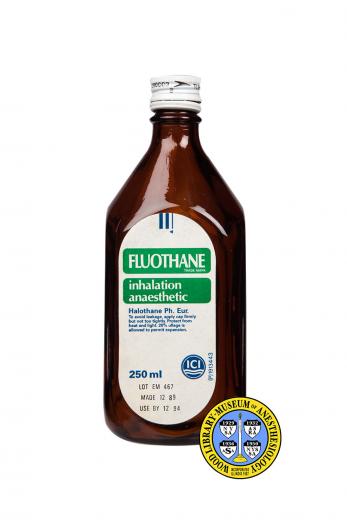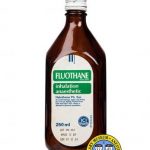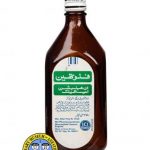Halothane
The first of a new generation of man-made, non-explosive liquid anesthetics was halothane (Fluothane.) More potent than ether, it allowed more rapid onset and faster recovery as well. It was synthesized in 1951 by Charles W. Suckling (born 1920) who worked for Imperial Chemical Industries (ICI.) It was introduced clinically in Great Britain in 1955. One of the first to use it in the United States was Dr. Ephraim S. Siker (1926-2013). Its advantages soon made it popular, but concerns over possible side effects led to the National Halothane Study. The authors of the study, published in 1969, concluded that the agent was as safe as other inhalation anesthetics. This bottle, labeled both in English and in Arabic, was manufactured by ICI , and was used by allied military forces in Operation Desert Storm (August 1990–February 1991.) The bottle was donated to the WLM by Dr. Roderick Calverley, who served in the U. S. Army during that conflict.
In the 1970s, some inhalation agents, including halothane, were shown to deplete the ozone layer. These were replaced in the 1990s with desflurane and sevoflurane, agents that do not impact the ozone layer.
Catalog Record: Halothane
Access Key: akhi
Accession No.: 1995-03-31-1 DW
Title: Fluothane : inhalation anaesthetic / ICI Pharmaceuticals.
Author: Suckling, Charles Walter.
Corporate Author: ICI Pharmaceuticals.
Title variation: Alt Title
Title: Halothane.
Publisher: Macclesfield, Cheshire, England : ICI Pharmaceuticals, 1989.
Physical Descript: 1 bottle : glass, aluminum, paper ; 16 x 6 x 6 cm.
Subject: Halothane.
Subject: Anesthetics, Inhalation.
Subject: Drug Packaging.
Note Type: Citation
Notes: O’Brien HD. Halothane: ave atque vale. Anaesth Intensive Care. 2006;34(suppl.
1):101-102.
Note Type: Not Applicable
Notes: O’Brien HD. The introduction of halothane into clinical practice: the Oxford
experience. Anaesth Intensive Care. 2006;34(suppl. 1):27-32.
Note Type: Citation
Notes: Whalen FX, Bacon DR, Smith HM. Inhaled anesthetics: an historical overview.
Best Pract Res Clin Anaesthesiol. 2005;19(3):323-330.
Note Type: Physical Description
Notes: One 250 ml dark amber glass bottle; The bottle is rectangular in shape with
rounded edges; It is toped by a screw-on aluminum cap that measures
approximately 2.2 cm in diameter; On one side of the bottle is a white paper
label marked with green, blue and black print in English; Markings include,
“FLUOTHANE [new line] inhalation [new line] anaesthetic, [new line] Halothane
Ph. Eur. [new line] To avoid leakage, apply cap firmly but not too tightly.
Protect from heat and light. 20% ullage is allowed to permit expansion., [new
line] 250 ml [new line] LOT EM 467 [new line] MADE 12 89, [new line] USE BY
12 94 [new line] [the Imperial Chemical Industries logo], (P)1913443”; On
the other side of the bottle is a white paper label marked with green, blue
and black print mostly in Arabic; At the bottle of this label some of the
print is in English; The English print includes, “Max. Retail Price Rs. 313.
60 [new line] ICI Pharmaceuticals [new line] Macclesfield Cheshire [new line]
England [new line] Made in Great Britain [new line] ML 29/1 Reg. No. 000527”.
Note Type: Reproduction
Notes: Photographed by Mr. Steve Donisch on January 15, 2013.
Note Type: Historical
Notes: Prior to the advent of Halothane anesthesiologists were limited to anesthetics that had at least one significant drawback, such as being flammable or explosive. Some caused severe nausea or heart rhythm problems, or required prolonged recovery times. (Recovery time is the time needed for all of the effects of the anesthetic to wear off). When researchers in England began testing Halothane in the clinical setting during the 1950s it was quickly recognized as a major advance in inhalation anesthetics because it was non-flammable, fast acting, and allowed for easier and more rapid recovery. The drug was approved by the FDA in 1958 and soon became the most frequently used inhalation anesthetic in the United States. By the early 1960s case reports of rare but significant adverse effects began to appear, and newer anesthetics slowly replaced Halothane. Halothane is no longer used in clinical practice in most developed countries. However because it is less expensive than more modern anesthetics, it continues to be used in developing countries and veterinary settings.
Note Type: Publication
Notes: Bunker JP, Forrest WH, Mosteller F, Vandam LD, eds. The National Halothane
Study: A Study of the Possible Association Between Halothane Anesthesia and
Postoperative Hepatic Necrosis. Bethesda, Md.: National Institutes of Health,
National Institute of General Medical Sciences; 1969. https://books.google.
com/books?id=ozUrAAAAYAAJ&lpg=PA1&ots=-3U4Mf3XtW&dq=Summary%20of%20the%20nati
nal%20Halothane%20Study&lr&pg=PR2#v=onepage&q=Summary%20of%20the%20national%2
Halothane%20Study&f=false. Accessed May 29, 2013.
Note Type: Publication
Notes: Giesecke AH. First use of halothane in the United States, C. Ronald Stephen,
M.D. (1916-2006). Bul Anesth Hist. 2008;26(2):1,4.
Note Type: Exhibition
Notes: Selected for the WLM website.



